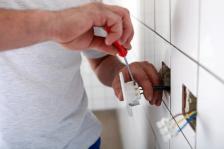How to Create a Wired Network at Home
If you want blazing fast speeds and the ability to multitask with all your devices, nothing beats a wired network. This week, Tech Talker explains all the steps you need to set up your own home wired network, from cabling, to design, to the finishing touches.


In a previous podcast, I talked about switches, routers, hubs, and bridges. In that episode I mentioned why having a wired home network would be extremely useful. Say you wanted to stream movies, home videos, share files, or back up all of your computers to your home network. Well, you can do that.
Mike and Bill both wanted to know more. So that’s why today, I’ll be covering just how to go about wiring your house with Cat6 internet cabling so that you can have an ultra fast wired home network of your own.
Sponsor: Get started with a free 30-day trial of eVoice®.
Step #1: Design Your Network
First things first – you’ll need to decide how many rooms you want to run your wired internet through. This will determine much of your price, because it will dictate how many feet of cable you’ll need to buy.
Next, you’ll want to find a good spot for all of the cables to meet at or the junction point; this is where you’ll put your switch or router. Keep in mind that you’ll have multiple wires coming out of your wall at this point. For this reason many people opt to have this location in a closet or behind a desk. Personally, I chose to have this be in my office closet. My reasoning is that it is centrally located in the house, it’s out of the way, and it’s still easily accessible if I want to make some changes.
Once you’ve found this junction spot, try and measure the distance from this spot to the desired locations in each room. The best way to accurately measure the length you’ll need is to imagine connecting a string from the junction point (where the router is) to the wall outlet. Always overestimate, and take into account that you might need to run the wire under your house, in the attic, or even through that walls!
Step #2: Decide on the Cable
Next you’ll have to decide on the type of cable that you want to use. There is Cat6, Cat5e, and Coaxial. Coaxial is generally used for TV, so I’ll just be covering Cat6 and Cat5e today. My advice is to just go with the Cat6, plain and simple. This cable is 10 times faster than Cat5e and isn’t much more expensive. Wiring your house will take a long time and it’s always better to do it right the first time. Depending on how much cable you’ve determined that you need I suggest buying a 1000′ spool (you can find it on Amazon or Monoprice). This will set you back about $100, but you’ll have a ton left over depending on the scope of your project.

Next there is the option of stranded or solid core wire. This basically means that the inside of your wire is made up of either braided strands or one solid piece. What this comes down to is how much manuevering you will need to do with the wire. If you’re going to be fishing it through tight spaces, a solid piece of wire is much easier to move around in a tight space because it is rigid. The downside to the solid core is that it is harder to connect to the wall outlet or plastic jack. Stranded wire is easy to connect to a wall outlet, but it’s pretty flimsy if you’re trying to push it through crevices.
Lastly, when choosing wire, go with something that is “in wall rated.” You shouldn’t get anything industrial because this will help keep the costs down.
Step #3: Wire the Cable

There are a lot of factors here to think about. All houses are built differently and have different access points. My house, for instance, has a raised foundation, so it’s easy for me to crawl underneath the floor and connect the rooms. Some people have access to their attic and can go up and over rooms. If neither of these options works for you, you might just have to go through the walls. Unless you have tons of experience with drywall and electrical installation, you should definitely consult a contractor or at least a knowledgeable individual before you start snagging waterlines and high voltage lines from inside your walls.
So far so good. You’ve determined the routes for your cables and all the best placement for your hardware. Now you must decide how you want your cables to come out of the wall. I like a nice clean look, personally. There are custom wall plates that make your cable into a wall jack. These are really handy, and look extremely professional. They are easy to install and look just like the faceplate that would go over a switch or wall outlet.
If you’ve ever installed a switch or outlet by cutting into the drywall, it’s the same process. This is pretty hard to describe in audio so I’ve posted some YouTube links on how to do this. After you’ve pushed and pulled your cable into place, be sure to test it to make sure it works! You can buy a cable tester but I just opted to use my laptop on one end and my router on the other. I transferred a file, checked the speed, and then tightened everything up.
With that, here are your Quick and Dirty Tips for creating a blazing fast home network:
- Figure out the best place to put your router/switch so that it is centrally located, yet stored out of sight.
- Make a list of locations where you want cable connections.
- Estimate how much cable you’ll need for your project.
- Figure out how you will route your cable (under the house, through the attic, or in the walls).
- Install faceplates for a clean finish.
Well that’s all for today! Have a question about anything in this episode? Or a suggestion for a future podcast? Send me an email at techtalker@quickanddirtytips.comcreate new email or post it on the Tech Talker Facebook wall.
As always check the shownotes to see a list of the programs I’ve mentioned in today’s episode. And go to quickanddirtytips tech-talker for a full archive of episodes.
Until next time, I’m the Tech Talker, keeping technology simple!
Cable wiring images courtesy of Shutterstock.






